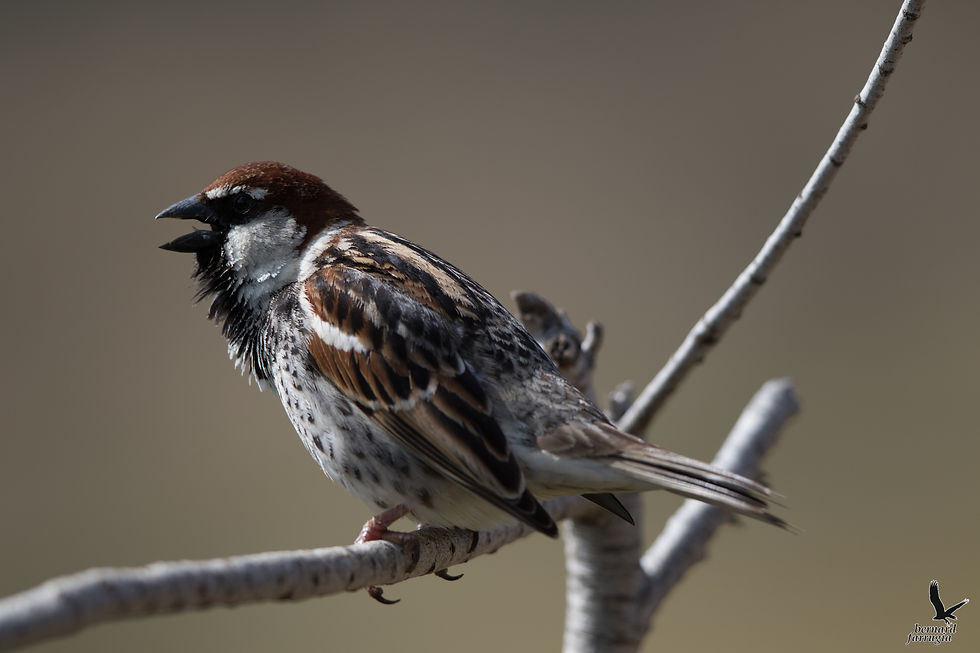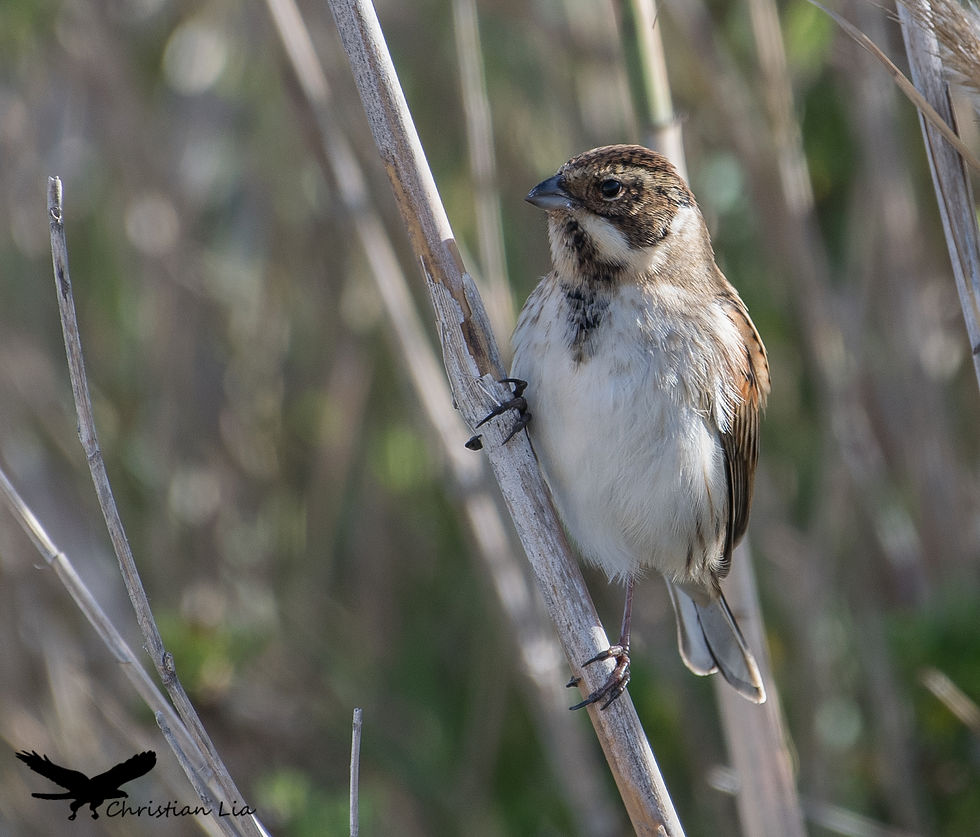
Sparrows & Buntings
Spanish Sparrow
Maltese name/s
Scientific binomen
Order
Family
Sighting occurrence
Info*
The most widespread bird of the Maltese Islands.
The Spanish Sparrow is a rather large sparrow, slightly larger and heavier than Tree Sparrows, and also has a slightly longer and stouter bill. The male is similar to the Tree Sparrow in plumage, but differs in that its underparts are heavily streaked with black, has a chestnut crown and has white cheeks.
Diet
Like other sparrows, it feeds principally on the seeds of grains and other grasses, also eating leaves, fruits, and other plant materials. Young birds are fed mostly on insects, and adults also feed on insects and other animals during and before the breeding season.
Longevity record
7 years 9 months (Spain, 2718667)
Usually seen in
All months
Occasionally seen in
-
Click on the image to open slideshow




Length (cm):
Weight (g):
14 - 16
24 - 33

Eurasian Tree Sparrow
Maltese name/s
Scientific binomen
Order
Family
Sighting occurrence
Info*
Usually seen in small groups, larger flocks but can be seen individually.
Differs from Spanish Sparrow by cheek patch, and lack of black breast markings. Brown and streaked rump. The black bib does not expand towards the chest. Head profile rounder and neater than Spanish Sparrow, with slightly smaller bill. Identification by profile alone is possible with practice. Sexes and ages alike.
Diet
Like other sparrows, it feeds principally on the seeds of grains and other grasses, also eating leaves, fruits, and other plant materials. Young birds are fed mostly on insects, and adults also feed on insects and other animals during and before the breeding season.
Longevity record
13 years 1 month (Found dead in France, 417586)
Ġaħġaħ
Passer montanus
Passeriformes
Passeridae
Fairly common
Usually seen in
October - November
Occasionally seen in
March - May, September, December
Click on the image to open slideshow




Length (cm):
Weight (g):
12.5 - 14
22 - 24

Snow Bunting
Maltese name/s
Scientific binomen
Order
Family
Sighting occurrence
Info*
Usually seen individually.
Easily recognized bunting with highly contrasting plumage. Tail with black center, boldly framed by white edges and white rump in all plumages. Males with white wings with black hand. Adult females with most inner parts of wings white, juveniles with white wing-bars only. A flock usually has a few adult males which gives away the species with their flashing white wings. Summer plumage of male white with black back, bill and legs. Female less pure white, with buffish head and cheeks. Juveniles mostly grey. Though most of adults white on wing is missing, the tail-pattern is diagnostic in flight also in young birds. In winter plumage the black parts of the plumage turn more brown and buff in both sexes.
Diet
Snow Buntings eat grass and flowering-plant seeds as well as insects and spiders. They pick seeds and insects from the ground or leap up from the ground to grab a seed or other prey.
Longevity record
10 years 2 month (Found dead in Iceland, 946781)
Usually seen in
November - December
Occasionally seen in
June
Click on the image to open slideshow
Length (cm):
Weight (g):
17 - 19
29 - 42

Corn Bunting
Maltese name/s
Scientific binomen
Order
Family
Sighting occurrence
Info*
Usually seen individually.
A featureless, bulky bunting. Larger than Yellowhammer, but with a shorter tail. Combination of size, build, flight-pattern and sound important for identification. Recalls the bigger larks in build. Takes off with a loose and surging flight, often with legs dangling underneath. Undulations particularly strong just before landing. Wings dark, and tail without white feathers or markings. "Tooth" in upper mandible visible at close range when singing. Bill and legs yellowish pink. Often shows an indistinct, dark breast patch.
Diet
Its natural food consists mainly of seeds but also includes insects such as crickets, especially when feeding young.
Longevity record
10 years 7 months (Czech Republic, Z 289597)
Usually seen in
March, October
Occasionally seen in
February, April, September, November
Click on the image to open slideshow




Length (cm):
Weight (g):
16 - 19
35 - 56

Ortolan Bunting
Maltese name/s
Scientific binomen
Order
Family
Sighting occurrence
Info*
Usually seen individually.
Medium sized bunting, resembling a compact Yellowhammer in shape. Head green with yellow markings and underparts orange-brown. Distinct and characteristic, yellow eye-ring and earth-brown (not rufous) rump in all plumages. Female like male, but duller coloured, with streaked head and chest.
Diet
Its natural food consists mainly of seeds but also includes insects such as crickets, especially when feeding young.
Longevity record
6 years 10 months (Hit by vehicle in Switzerland, E 966705)
Usually seen in
April
Occasionally seen in
March, May, August - October
Click on the image to open slideshow


Length (cm):
Weight (g):
15 - 16.5
21 - 27

Cirl Bunting
Maltese name/s
Scientific binomen
Order
Family
Sighting occurrence
Info*
Usually seen individually.
Slightly more compact than Yellowhammer, with shorter wings and heavier bill. In all plumages note; olive to grey rump, greyish lesser coverts and finely streaked flanks. Male unmistakable with black throat and eye-stripe. Female and immature lacks black throat, but have more contrasting eye- and moustache-stripe than Yellowhammer.
Diet
Its natural food consists mainly of seeds but also includes insects such as crickets, especially when feeding young.
Longevity record
-
Usually seen in
November - December
Occasionally seen in
August - September
Click on the image to open slideshow
Length (cm):
Weight (g):
15 - 16.5
22 - 31

Yellowhammer
Maltese name/s
Scientific binomen
Order
Family
Sighting occurrence
Info*
Usually seen individually.
Large and long-tailed bunting with rufous rump. Mainly yellow and brown plumage. Head bright yellow with dark markings in breeding male. Female darker, with streaked head, yellow throat and supercilium. Back greyish and streaked. Rufous rump distinguishes it from Ortolan and Cirl Bunting. Underparts pale yellow, with relatively coarse streaking.
Diet
The diet of the Yellowhammer is rather varied, and consists of seeds, grain, some small fruits such as blackberries, insects and spiders.
Longevity record
13 years 3 months (Found dead in the UK, JC 97236)
Usually seen in
October - December
Occasionally seen in
January, August - September
Click on the image to open slideshow


Length (cm):
Weight (g):
15.5 - 17
24 - 37

Common Reed Bunting
Maltese name/s
Scientific binomen
Order
Family
Sighting occurrence
Info*
Usually seen individually.
Breeding male easily recognized by all black head, prominent white moustache stripe and white collar. Rufous greater coverts in young birds. Females and juveniles otherwise plain and rather characterless, and are easily confused with other rare buntings. Reed bunting however, lacks the pale eye-ring and plain cheeks of Little Bunting, and the rufous rump of Rustic Bunting.
Diet
Its diet consists of seeds, grain, small fruits, insects and spiders.
Longevity record
12 years 3 months (Switzerland, A 220452)
Usually seen in
November - December
Occasionally seen in
January - May, July
Click on the image to open slideshow




Length (cm):
Weight (g):
13.5 - 15.5
15 - 24
.jpg)
Little Bunting
Maltese name/s
Scientific binomen
Order
Family
Sighting occurrence
Info*
Usually seen individually.
Small bunting with warm rufous cheeks framed in black. Often with a pale spot hind-cheek, towards the neck. Pale eyering, pale wing-bar, rufous median and black lateral crown-stripe . Bill grey with straight culmen. Easily confused with female Reed Bunting. In addition to mentioned criteria, also note pinkish legs and much paler lores. Sexes more or less alike, but birds with rufous throat and contrasting crown-stripes are usually males.
Diet
Its diet consists of seeds, grain, small fruits, insects and spiders.
Longevity record
-
Usually seen in
October - November
Occasionally seen in
December, April
Click on the image to open slideshow
Length (cm):
Weight (g):
12 - 13.5
12 - 13

Rustic Bunting
Maltese name/s
Scientific binomen
Order
Family
Sighting occurrence
Info*
Usually seen individually.
All plumages differs from Reed Bunting, and most other buntings by; white belly, pale cheek-patch, flanks coarsely spotted in rufous red, rufous rump with no streaking, pale pinkish legs and lower mandible. Summer plumage male easily recognized by boldly rufous breast and contrasting black and white head pattern. Young male resembles females, and may breed before adult plumage is fully developed. Posture often erect when moving around on the ground. Crown feathers often erect. Flight pattern light and fluttering, and more even than in Reed Bunting.
Diet
Its diet consists of seeds, grain, small fruits, insects and spiders.
Longevity record
-
Usually seen in
October - November
Occasionally seen in
February, September
Click on the image to open slideshow
Length (cm):
Weight (g):
13 - 14.5
16.5 - 23

*Some information was sourced from ''BirdID Nord University''.
